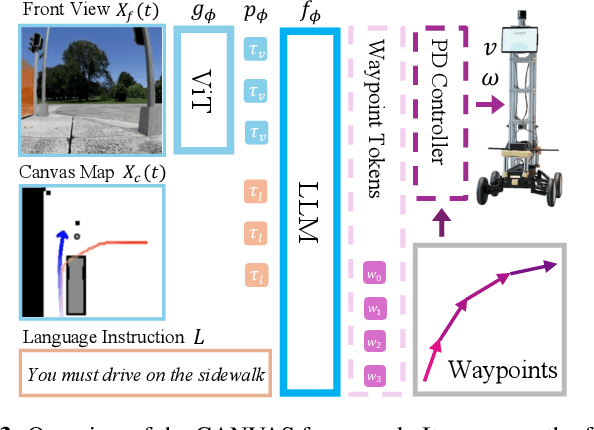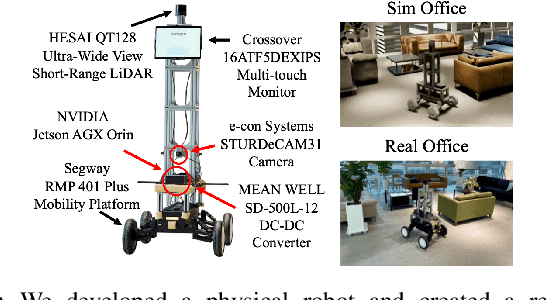Minseo Kim
DisCoRD: Discrete Tokens to Continuous Motion via Rectified Flow Decoding
Dec 02, 2024Abstract:Human motion, inherently continuous and dynamic, presents significant challenges for generative models. Despite their dominance, discrete quantization methods, such as VQ-VAEs, suffer from inherent limitations, including restricted expressiveness and frame-wise noise artifacts. Continuous approaches, while producing smoother and more natural motions, often falter due to high-dimensional complexity and limited training data. To resolve this "discord" between discrete and continuous representations, we introduce DisCoRD: Discrete Tokens to Continuous Motion via Rectified Flow Decoding, a novel method that decodes discrete motion tokens into continuous motion through rectified flow. By employing an iterative refinement process in the continuous space, DisCoRD captures fine-grained dynamics and ensures smoother and more natural motions. Compatible with any discrete-based framework, our method enhances naturalness without compromising faithfulness to the conditioning signals. Extensive evaluations demonstrate that DisCoRD achieves state-of-the-art performance, with FID of 0.032 on HumanML3D and 0.169 on KIT-ML. These results solidify DisCoRD as a robust solution for bridging the divide between discrete efficiency and continuous realism. Our project page is available at: https://whwjdqls.github.io/discord.github.io/.
CANVAS: Commonsense-Aware Navigation System for Intuitive Human-Robot Interaction
Oct 02, 2024



Abstract:Real-life robot navigation involves more than just reaching a destination; it requires optimizing movements while addressing scenario-specific goals. An intuitive way for humans to express these goals is through abstract cues like verbal commands or rough sketches. Such human guidance may lack details or be noisy. Nonetheless, we expect robots to navigate as intended. For robots to interpret and execute these abstract instructions in line with human expectations, they must share a common understanding of basic navigation concepts with humans. To this end, we introduce CANVAS, a novel framework that combines visual and linguistic instructions for commonsense-aware navigation. Its success is driven by imitation learning, enabling the robot to learn from human navigation behavior. We present COMMAND, a comprehensive dataset with human-annotated navigation results, spanning over 48 hours and 219 km, designed to train commonsense-aware navigation systems in simulated environments. Our experiments show that CANVAS outperforms the strong rule-based system ROS NavStack across all environments, demonstrating superior performance with noisy instructions. Notably, in the orchard environment, where ROS NavStack records a 0% total success rate, CANVAS achieves a total success rate of 67%. CANVAS also closely aligns with human demonstrations and commonsense constraints, even in unseen environments. Furthermore, real-world deployment of CANVAS showcases impressive Sim2Real transfer with a total success rate of 69%, highlighting the potential of learning from human demonstrations in simulated environments for real-world applications.
Selective Vision is the Challenge for Visual Reasoning: A Benchmark for Visual Argument Understanding
Jun 27, 2024



Abstract:Visual arguments, often used in advertising or social causes, rely on images to persuade viewers to do or believe something. Understanding these arguments requires selective vision: only specific visual stimuli within an image are relevant to the argument, and relevance can only be understood within the context of a broader argumentative structure. While visual arguments are readily appreciated by human audiences, we ask: are today's AI capable of similar understanding? We collect and release VisArgs, an annotated corpus designed to make explicit the (usually implicit) structures underlying visual arguments. VisArgs includes 1,611 images accompanied by three types of textual annotations: 5,112 visual premises (with region annotations), 5,574 commonsense premises, and reasoning trees connecting them to a broader argument. We propose three tasks over VisArgs to probe machine capacity for visual argument understanding: localization of premises, identification of premises, and deduction of conclusions. Experiments demonstrate that 1) machines cannot fully identify the relevant visual cues. The top-performing model, GPT-4-O, achieved an accuracy of only 78.5%, whereas humans reached 98.0%. All models showed a performance drop, with an average decrease in accuracy of 19.5%, when the comparison set was changed from objects outside the image to irrelevant objects within the image. Furthermore, 2) this limitation is the greatest factor impacting their performance in understanding visual arguments. Most models improved the most when given relevant visual premises as additional inputs, compared to other inputs, for deducing the conclusion of the visual argument.
 Add to Chrome
Add to Chrome Add to Firefox
Add to Firefox Add to Edge
Add to Edge